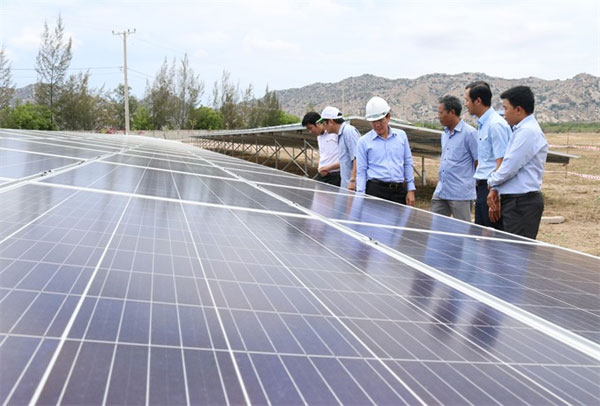[ad_1]
VietNamNet Bridge – Renewable energy projects are facing challenges in licensing, financing options, and agreements with local project owners, experts said at a seminar held in HCM City on Thursday.
 |
|
Solar panels at BIM 1 Solar power Plant in Phuoc Minh Commune, Thuan Nam District in the central province of Ninh Thuan. — VNA/VNS Photo Nguyen Thanh
|
Nguyen Quang Thuan, CEO of StoxPlus Corporation, the seminar’s organiser, said: “We would like to share not only market insights and lessons learned from project implementation experiences, but also key issues and risks about project development, financing, merger and acquisitions, and equity investment.”
Speaking at the “Viet Nam Renewable Energy: Challenges and Practical Solutions” seminar, Stefano Pellegrino, general secretary of EuroCham Viet Nam, a co-organiser of the seminar, said that renewable energy development “is more and more important, and EuroCham would like to promote clean and sustainable energy in Vietnam”.
Le Xuan Dong, chief financial officer and director of Business Information Services for StoxPlus, said Prime Minister Nguyen Xuan Phuc issued a decision last year to encourage the development of solar power, and five months later, the Ministry of Industry and Trade issued a circular on the issue, including the feed-in tariff (FiT) rate of 9.35 cents per kWh.
“Foreign and local investors are excited about renewable energy in Vietnam, which is expected to grow at 23.2 per cent annually during the 2020-30 period,” he said.
“Despite the rush, out of 24 GW of renewable energy’s registered capacity, only 19 per cent have made it to the construction stage, while 8 per cent are in operations. Most projects are still in the preparation stage,” Dong added.
By the end of July, projects with around 12,622MW solar energy capacity were still in the pre-investment stage; 1,432MW in the design and feasibility study stage; 1,002MW (equivalent with 7 per cent) in the construction stage; and only 8MW (0.1 per cent) in the operating stage.
Wind power projects have become even more difficult to implement than solar energy because of the current low FiT.
“Only 5,700MW of wind power projects are in the stages of pre-investment, design and feasibility studies, construction, or operational stage, much lower than the total MW of solar energy,” he said.
“Biomass uses cheap feedstocks available in the delta regions of the country, including biogases and other agricultural by-products. Hence, there are more biomass projects in construction and in operation,” Đông added.
Biomass projects are expected to generate about 900MW.
Dak Lak, Ninh Thuan, Binh Thuan, Quang Tri and Quang Ngai provinces are the top five areas with the highest planned solar energy capacity.
Bac Lieu, Soc Trang, Binh Thuan, Ninh Thuan and Ben Tre provinces rank at the top for wind-energy capacity, while Gia Lai, Khanh Hoa, Quang Binh, Dak Lak and Phu Yen provinces have the most potential for biomass.
“Because renewable energy is in the nascent stage, developers are encountering challenges from many sides,” Dong said.
He said that the main legal risk comes from the Power Purchase Agreement (PPA), which foreign lenders have deemed unbankable due to its non-negotiability and difficulty in enforcement.
“Even if the PPA is signed, the fixed low FiT could have an impact on profitability and the payback period of the project,” he added. “Local developers also face operational risks such as project delays, overloaded transmission lines in rural areas, and procurement of low quality equipment.”
Current undercapitalisation and low long-term sources of funding make it difficult to borrow from domestic lenders over the long term.
Oliver Behrend, principal investment officer for the International Finance Corporation (IFC), said: “Vietnam has a lot of projects, but has a low conversion rate because of lack of funds.”
Most projects are being financed via international banks, while local banks provide the guarantee.
“It is complicated and requires considerable structuring, risk arbitrage and limited availability,” he said. “Right now, Vietnam may have enough to finance for 1,000 – 2,000MW, but what about the next 10GW to the year 2030?”
He said the country should have a more competitive procurement environment.
“Technology costs have fallen significantly, especially in solar energy. Emergence of large, sophisticated market players has led to reduced risks and economies of scale,” Behrend said.
“The reduction of technology and execution risks have led to a decrease in the cost of capital and an increase in the availability of capital for solar energy,” he said. “The increasing trend to procure solar via competitive auctions has also led to decreased costs.”
“Vietnam should lower costs of power and provide financing for 12GW of solar and 6GW of wind, with would require international debt and equity capital,” he added.
Source: VNS
| related news |
[ad_2]
Source link
